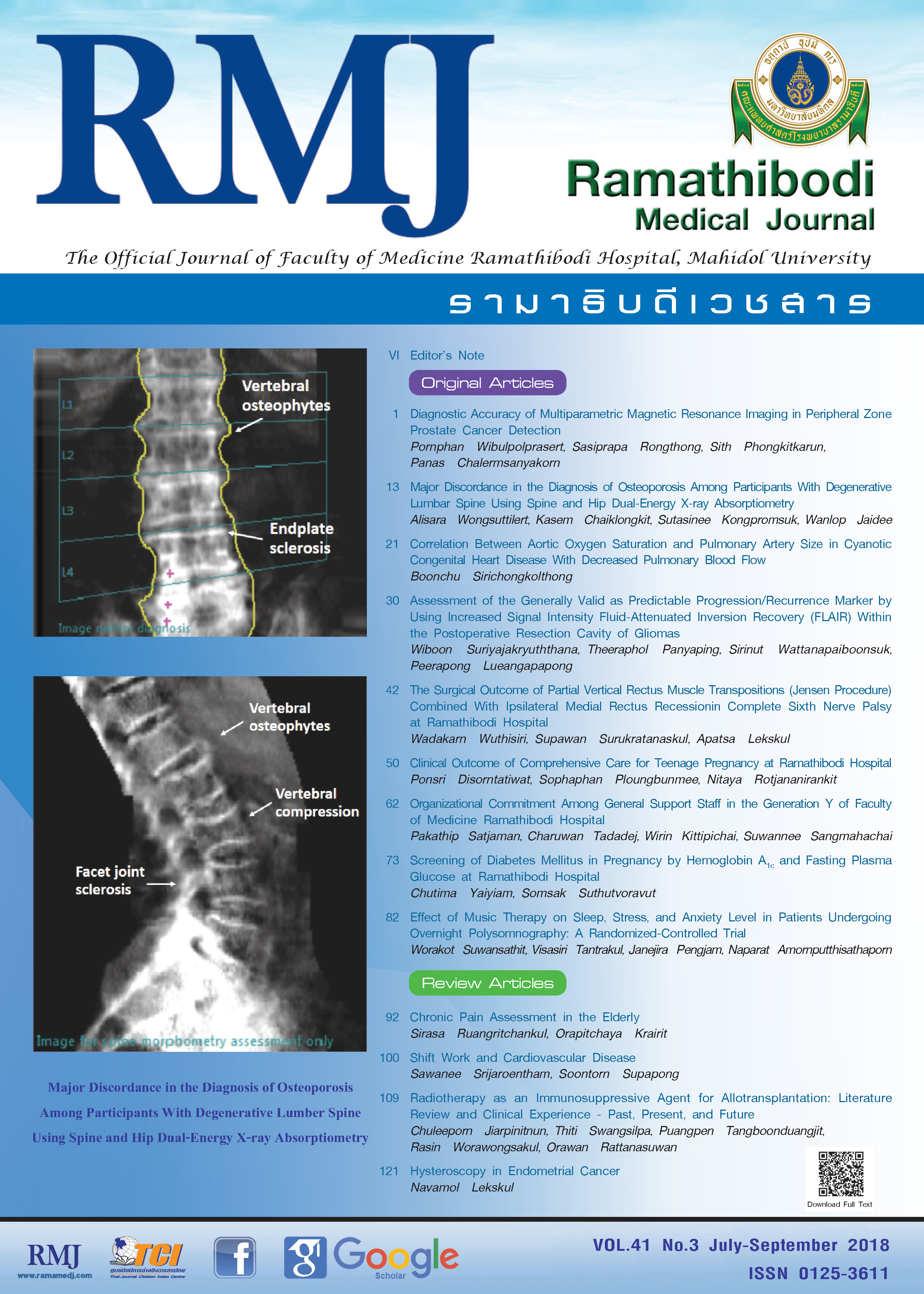Hysteroscopy in Endometrial Cancer
Main Article Content
Abstract
Endometrial cancer is one of the most common gynecological malignancies. The majority of the patients present with abnormal vaginal bleeding; hence, the disease is diagnosed in the early stages. Usually transvaginal ultrasound and endometrial biopsy are the beneficial investigations, notably with occasional failure to obtain adequate endometrial tissue. Hysteroscopy increases the sensitivity and accuracy to identify endometrial cancer; however, the pressure of fluid distension media should be optimized because of the concern of impaired prognosis from malignant cell spillage. In sentinel lymph node mapping, hysteroscopic injection is considered as a method to potentially increase the detection rate in the para-aortic area. Fertility-sparing treatment of endometrial cancer in early stages is feasible with the combination of hysteroscopic resection and progestin therapy.
Article Details
References
Ferlay J, Soerjomataram I, Ervik M, at al. GLOBOCAN 2012 v1.0, Cancer Incidence and Mortality Worldwide: IARC CancerBase No. 11. Lyon, France: International Agency for Research on Cancer; 2013. https://globocan.iarc.fr. Accessed May 24, 2018.
van Hanegem N, Prins MM, Bongers MY, et al. The accuracy of endometrial sampling in women with postmenopausal bleeding: a systematic review and meta-analysis. Eur J Obstet Gynecol Reprod Biol. 2016;197:147-155. doi:10.1016/j.ejogrb.2015.12.008.
Dueholm M, Hjorth IM. Structured imaging technique in the gynecologic office for the diagnosis of abnormal uterine bleeding. Best Pract Res Clin Obstet Gynaecol. 2017;40:23-43. doi:10.1016/j.bpobgyn.2016.09.010.
Gupta JK, Chien PF, Voit D, Clark TJ, Khan KS. Ultrasonographic endometrial thickness for diagnosing endometrial pathology in women with postmenopausal bleeding: a meta-analysis. Acta Obstet Gynecol Scand. 2002;81(9):799-816. doi:10.1034/j.1600-0412.2001.810902.x.
ACOG committee opinion no. 734: The role of transvaginal ultrasonography in evaluating the endometrium of women with postmenopausal bleeding. Obstet Gynecol. 2018;131(5):e124-e129. doi:10.1097/AOG.0000000000002631.
Xie B, Qian C, Yang B, et al. Risk factors of unsuccessful office-based endometrial biopsy: a comparative study of office-based endometrial biopsy (Pipelle) and diagnostic dilatation and curettage. J Minim Invasive Gynecol. 2018;25(4):724-729. doi:10.1016/j.jmig.2017.11.018.
Martinelli F, Ditto A, Bogani G, et al. Accuracy of pre-operative hysteroscopic guided biopsy for predicting final pathology in uterine malignancies. J Cancer Res Clin Oncol. 2017;143(7):1275-1279. doi:10.1007/s00432-017-2371-0.
Gkrozou F, Dimakopoulos G, Vrekoussis T, et al. Hysteroscopy in women with abnormal uterine bleeding: a meta-analysis on four major endometrial pathologies. Arch Gynecol Obstet. 2015;291(6):1347-1354. doi:10.1007/s00404-014-3585-x.
Ianieri MM, Staniscia T, Pontrelli G, et al. A new hysteroscopic risk scoring system for diagnosing endometrial hyperplasia and adenocarcinoma. J Minim Invasive Gynecol. 2016;23(5):712-718. doi:10.1016/j.jmig.2016.02.017.
Ørtoft G, Dueholm M, Mathiesen O, et al. Preoperative staging of endometrial cancer using TVS, MRI, and hysteroscopy. Acta Obstet Gynecol Scand. 2013;92(5):536-545. doi:10.1111/aogs.12103.
Surico D, Vigone A, Leo L. Narrow band imaging in endometrial lesions. J Minim Invasive Gynecol. 2009;16(1):9-10. doi:10.1016/j.jmig.2008.07.003.
Surico D, Vigone A, Bonvini D, Tinelli R, Leo L, Surico N. Narrow-band imaging in diagnosis of endometrial cancer and hyperplasia: a new option? J Minim Invasive Gynecol. 2010;17(5):620-625. doi:10.1016/j.jmig.2009.10.014.
Tinelli R, Surico A, Leo L, et al. Accuracy and efficacy of narrow-band imaging versus white light hysteroscopy for the diagnosis of endometrial cancer and hyperplasia: a multicenter controlled study. Menopause. 2011;18(9):1026-1029. doi:10.1097/gme.0b013e31821221cd.
Kisu I, Banno K, Kobayashi Y, et al. Flexible hysteroscopy with narrow band imaging (NBI) for endoscopic diagnosis of malignant endometrial lesions. Int J Oncol. 2011;38(3):613-618. doi:10.3892/ijo.2011.903.
Polyzos NP, Mauri D, Tsioras S, Messini CI, Valachis AV, Messinis IE. Intraperitoneal dissemination of endometrial cancer cells after hysteroscopy: a systematic review and meta-analysis. Int J Gynecol Cancer. 2010;20(2):261-267. doi:10.1111/IGC.0b013e3181ca2290.
Chang YN, Zhang Y, Wang YJ, Wang LP, Duan Hua. Effect of hysteroscopy on the peritoneal dissemination of endometrial cancer cells: a meta-analysis. Fertil Steril. 2011;96(4):957-961. doi:10.1016/j.fertnstert.2011.07.1146.
Dovnik A, Crnobrnja B, Zegura B, Takac I, Pakiz M. Incidence of positive peritoneal cytology in patients with endometrial carcinoma after hysteroscopy vs. dilatation and curettage. Radiol Oncol. 2016;51(1):88-93. doi:10.1515/raon-2016-0035.
Chen J, Clark LH, Kong WM, et al. Does hysteroscopy worsen prognosis in women with type II endometrial carcinoma? PLoS One. 2017;12(3):e0174226. doi:10.1371/journal.pone.0174226.
Stachowicz N1, Mazurek D, Łoziński T, Czekierdowski A. Diagnostic hysteroscopy and the risk of malignant cells intraabdominal spread in women with endometrial cancer. Ginekol Pol. 2017;88(10):562-567. doi:10.5603/GP.a2017.0101.
Kang S, Yoo HJ, Hwang JH, Lim MC, Seo SS, Park SY. Sentinel lymph node biopsy in endometrial cancer: meta-analysis of 26 studies. Gynecol Oncol. 2011;123(3):522-527. doi:10.1016/j.ygyno.2011.08.034.
Rossi EC, Kowalski LD, Scalici JS, et al. A comparison of sentinel lymph node biopsy to lymphadenectomy for endometrial cancer staging (FIRES trial): a multicenter, prospective, cohort study. Lancet Oncol. 2017;18(3):384-392. doi:10.1016/S1470-2045(17)30068-2.
Bodurtha Smith AJ, Fader AN, Tanner EJ. Sentinel lymph node assessment in endometrial cancer: a systematic review and meta-analysis. Am J Obstet Gynecol. 2017;216(5):459-476.e10. doi:10.1016/j.ajog.2016.11.1033.
Martinelli F, Ditto A, Sigmorelli M, et al. Sentinel node mapping in endometrial cancer following hysteroscopic injection of tracers: a single center evaluation over 200 cases. Gynecol Oncol. 2017;146(3):525-530. doi:10.1016/j.ygyno.2017.06.014.
Holloway RW, Abu-Rustum NR, Backes FJ, et al. Sentinel lymph node mapping and staging in endometrial cancer: a Society of Gynecologic Oncology literature review with consensus recommendations. Gynecol Oncol. 2017;146(2):405-415. doi:10.1016/j.ygyno.2017.05.027.
Mazzon I, Corrado G, Masciullo V, Morricone D, Ferrandina G, Scambia G. Conservative surgical management of stage IA endometrial carcinoma for fertility preservation. Fertil Steril. 2010;93(4):1286-1289. doi:10.1016/j.fertnstert.2008.12.009.
Alonso S, Castellanos T, Lapuente F, Chiva L. Hysteroscopic surgery for conservative management in endometrial cancer: a review of literature. Ecancermedicalscience. 2015;9:505. doi:10.3332/ecancer.2015.505.
De Marzi P, Bergamini A, Luchini S, et al. Hysteroscopic resection in fertility-sparing surgery for atypical hyperplasia and endometrial cancer: safety and efficacy. J Minim Invasive Gynecol. 2015;22(7):1178-1182. doi:10.1016/j.jmig.2015.06.004.
Falcone F, Laurelli G, Losito S, Di Napoli M, Granata V, Greggi S. Fertility preserving treatment with hysteroscopic resection followed by progestin therapy in young women with early endometrial cancer. J Gynecol Oncol. 2017;28(1):e2. doi:10.3802/jgo.2017.28.e2.




